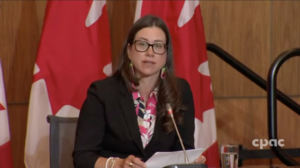New National Indigenous Economic Strategy unveiled, stressing importance of socioeconomic parity for Indigenous people

By Rick Garrick
OTTAWA — A new National Indigenous Economic Strategy featuring four strategic pathways — People, Lands, Infrastructure and Finance — was unveiled by a coalition of more than 25 national Indigenous organizations on June 6 in Ottawa.
“The strategy begins with a simple compelling vision that we see to be a requirement for economic reconciliation, and that is socioeconomic parity for Indigenous peoples in Canada,” says Dawn Madahbee Leach, National Indigenous Economic Strategy spokesperson and Aundeck Omni Kaning citizen. “Reconciliation is everyone’s business — one of the most nefarious objectives of colonialism was the intentional exclusion of Indigenous peoples from sharing in the wealth that arose from our own lands. It will take a concerted effort from all sectors of the economy to reverse these impacts of that exclusion.”
Madahbee Leach says the first of the four strategic pathways, People, aims to strengthen the capacity of First Nations, Métis, and Inuit people where they have world-class skills, knowledge, and leadership in Canadian and global economies.
“The second pathway, Lands, is based in the knowledge that our lands were never ceded but were intended to be shared and protected for future generations,” Madahbee Leach says. “The third pathway, Infrastructure, envisions a future where leading-edge physical and institutional infrastructure is in place for our people and communities. Effective infrastructure is crucial to ensuring a prosperous Indigenous economy.”
Madahbee Leach says the guiding vision for the fourth pathway, Finance, is for Indigenous peoples and communities to have the financial capital to achieve economic and social prosperity on their own terms.
“The four strategic pathways are designed to shift the status quo from managing poverty to growing prosperity,” Madahbee Leach says. “A recent study conducted by the Canadian Centre for Policy Alternatives found that Indigenous children in Canada are more than twice as likely to live in poverty than non-Indigenous children. The time for this strategy is now — to accelerate our collective efforts to eradicate poverty and achieve a more inclusive Canadian economy.”

Tabatha Bull, president and CEO at Canadian Council for Aboriginal Business and Nipissing citizen, says the Indian Act contained a permit system until 2014 that controlled First Nations abilities to sell products off-reserve.
“Until 1951, Indigenous peoples were not considered Indians under the Indian Act if they obtained a post-secondary school degree, which then meant if you were a lawyer, an engineer, a doctor, your Indian Status was stripped away,” Bull says. “We lost mentors and role models for our youth and the opportunity to create intergenerational wealth. This is why we all have a role to support an Indigenous economy and why we must work together to ensure all Canadians are dedicated to building respectful economic partnerships.”
Bull says Indigenous peoples are the youngest and fastest growing demographic in Canada, and they are creating businesses at nine times the rate of non-Indigenous Canadians.
“There are close to 60,000 Indigenous businesses across Canada in every sector and size in every province and territory,” Bull says. “Additionally, Indigenous businesses are three times more likely to introduce a new product or service and twice as likely to introduce a new process or way of doing things, particularly businesses led by Indigenous women.”
Bull says the Indigenous population in Canada contributes more than $30 billion annually to Canada’s GDP, with the private sector economy contributing more than $12 billion.
“The potential to grow to over $100 billion exists,” Bull says. “The outlook is positive but there remains significant work to do — it will take all of us to be active participants in reconciliation. Without all of us, our country will not prosper.”
Madahbee Leach says the strategy also features 107 Calls to Economic Prosperity that provide a guide or road map for the country to achieve economic reconciliation.
“It’s been proven that wherever Indigenous communities prosper, so does the region around them,” Madahbee Leach says. “We’ve seen regional and provincial reports that show how much in the way of contributions that Indigenous people make to local and regional economies. As the businesses grow, they spend money in the region and that means jobs for everyone.”
Information about the strategy is posted online.

